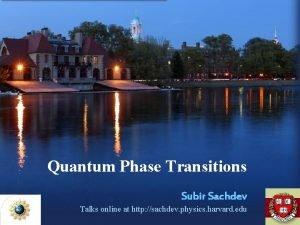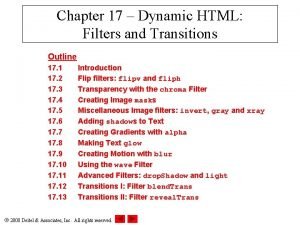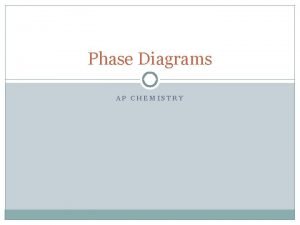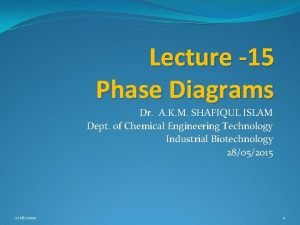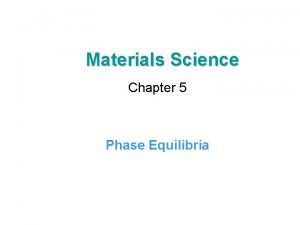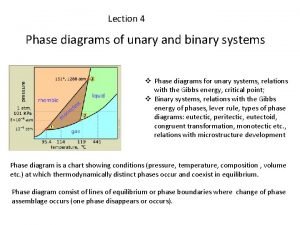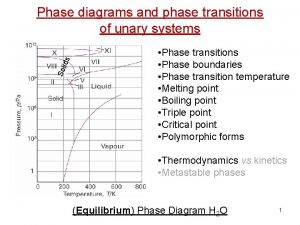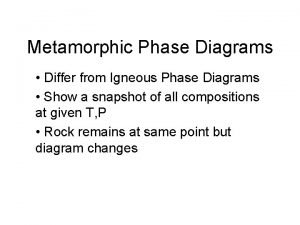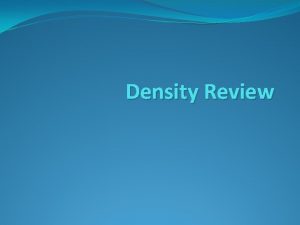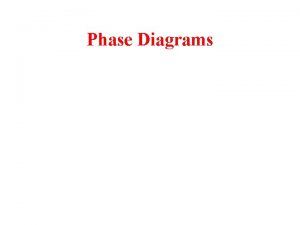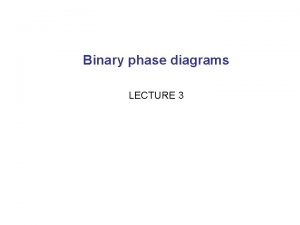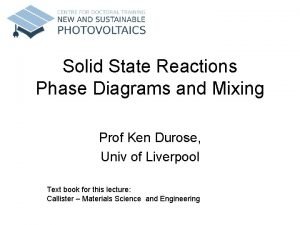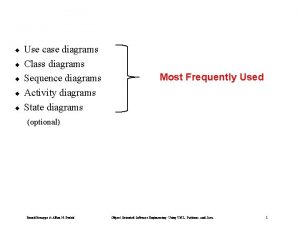Solid State Solutions Phase Diagrams and Phase Transitions
























- Slides: 24

Solid State Solutions, Phase Diagrams, and Phase Transitions Matt Highland ‣ Synthesis away from ‣ ‣ equilibrium Metastable Materials Reactive Synthesis Second Workshop on Photocathodes: 300 nm-500 nm June 29 -30 at the University of Chicago

Synthesis away from Equilibrium ‣ Typical thermodynamics gives us guide posts on synthesis near equilibrium ‣ Engineering materials with specific properties often requires synthesis away from equilibrium ‣ “Metastable” materials that demand non-equilibrium and kinetically ‣ controlled synthesis path ways Metastable synthesis requires additional stabilization during growth: Strain Epitaxy Energetic ions Sputtering Chemical Activity Reactive Synthesis Sr. Ru. O 3 and Co 3 O 4 2

Reactive Synthesis of Metastable Materials ‣ Reactive synthesis utilizes activity of chemical precursors to ‣ stabilize desired phases Practical example: (In, Ga)N solid solutions ‣ Band-gap tunable across solar spectrum by varying solid solution content LEDs for solid state lighting 3

In. Ga. N: The promise and truth • Solid-state lighting has the • potential reduce U. S. energy consumption from 3. 1 to 2. 1 petawatt-hours/year* Roughly the output of 250 coal fired power plants ‣ The truth • External quantum efficiency • drops as In. N content increases Driven by problems with crystal quality and the metastable nature of In. N *“Energy Savings Potential of Solid State Lighting in General Illumination Applications”, http: //www. netl. doe. gov/ssl External quantum efficiency, hext ‣ The promise High-power (>1 Watt input) visible-spectrum LEDs Inx. Ga 1 -x. N (Alx. Ga 1 -x)0. 52 In 0. 48 P V( V(l) l) Tj = 25 C Peak wavelength, lp (nm)

The Fundamental Problem ‣ At desirable growth temperatures required nitrogen activity is equivalent to kilobars (~104 psi) of N 2 ‣ During MOCVD growth nitrogen activity provided by cracking ammonia ‣ Reaction we want to avoid: Ambacher et al. , JVST B 14, 3532 (1996) 55

Intermediate Chemical Species ‣ We know the overall reaction desired for growth ‣ However what are the intermediate chemical species that drive this growth ? • All we know is the precursors crack somehow interact 66

Attacking a Problem on Multiply Fronts ‣ We’re employing multiply in-situ probes and computational techniques to understand the details of reactive synthesis In-situ IR spectroscopy In-situ X-ray Analysis Theory & modeling 77

Probing the Growth Environment ‣ Synchrotron x-rays are capable ‣ ‣ to penetrating the MOCVD environment and yield structural and elemental details in real time • In-situ MOCVD reactor at sector 12 ID-D of the Advanced Photon Source Diffraction from Ga. N surfaces and In. N crystals X-ray Fluorescence from deposited Indium Movie camera Fluorescence Detector Visible illumination Synchrotron x-rays Scattering Detector ‣ Measurements reveal a very complex growth behavior 8 88

In-In. N Phase Boundaries ‣ By monitoring In. N and In liquid formation we can map out an indium condensation phase diagram ‣ Upon increasing TMI flow • At higher temp, elemental In • In liquid droplets liquid condenses At lower T, relaxed In. N solid particles grow Bare Ga. N surface p. NH 3= 27 Torr In. N crystals F. Jiang, et al. PRL 101, 086102 (2008)

Oscillatory Growth and Decomposition ‣ Near phase boundaries system can spontaneously oscillate • Inter-conversion between In. N and liquid In ‣ AFM of quenched samples shows microstructure of distinct surface species Epitaxial In. N islands Elemental In droplets F. Jiang, et al. PRL 101, 086102 (2008) 10

Chemical Wave Patterns ‣ Spatial variation between In. N and In can be resolved optically • Dark regions: In. N • White regions: In liquid ‣ Waves of In. N or In liquid • Sweep across the sample • Form concentric rings • Spiral patterns F. Jiang, et al. PRL 101, 086102 (2008) 11

What Drives the Oscillatory Behavior ? ‣ The key to this complex growth behavior is local nitrogen activity ‣ NH 3 impinges on the hot sample surface, cracks and forms some highly active ‣ ‣ chemical species (NHx) These active species either interact with In and form In. N or react to eventually form N 2 and leave the surface. The efficiency with which NH 3 is cracked and the residence time of the intermediate species determines which material grows 12 12

Oscillatory Growth Mechanism NH 3 cracks on the Ga. N of In. N surface and forms the intermediate species that allow In. N to grow Critical amount of liquid In metal condenses which accelerates conversion of NH 3 to N 2 and In. N starts to decompose Liquid In metal evaporates to expose Ga. N surface and In. N growth starts again

Intermediate Chemical Species ‣ The local intermediate chemical species dictate growth behavior ‣ Different surfaces catalytically crack NH 3 differently and possibly change residence time of intermediate species ‣ If we can understand which intermediate species enable In. N growth, then we can better stabilize and encourage its formation ‣ What are the intermediate nitrogen species? • First principle calculations • Additional in-situ probes 14 14

First-principle Calculations ‣ We can calculate the lowest energy configurations of NH 3, NH 2, NH, N, and H on a Ga. N and In. N surface ‣ We can then create a phase diagram predicting the equilibrium coverage species for given conditions • “We” = Peter Zapol, Weronika Walkosz, and Xin Tan fixed (2 x 2) surface unit cell - 4 H 3 “hollow” sites - 4 T 1 “on top” Ga sites - 4 T 4 “on top” N sites - 12 br “bridge” site

Predicted Phase Diagram Predicted structures on Ga. N surface ‣ Lowest energy surface species differ depending temperature and nitrogen activity ‣ One of these configuration maybe be what enable In. N growth ‣ Can we find these phases experimentally ? N-rich Ga-rich W. Walkosz, et al. PRB 85, 033308 (2012)

Surface and Crystal Truncation Rods ‣ An abrupt crystalline surface in real‣ space creates an extended rod of scattering in reciprocal space Scattering that occurs along this Crystal Truncation Rod (CTR) away from the Bragg peaks is very sensitive to surface changes (10 L) CTR (00 L) CTR 17

Predicted CTRs Predicted structures on Ga. N surface ‣ First Principle can be used to predict CTRs for each phase ‣ Can we see these changes with in-situ x-rays ? W. Walkosz, et al. PRB 85, 033308 (2012) N-rich Ga-rich

Experimentally measured CTRs ‣ With different amounts of NH 3, N 2, and H 2 in the sample environment we ‣ see large changes at anti-Bragg conditions Modeling shows that CTR changes are consistent with a number of predicted surface structures • Uniqueness problem: Modeling generates a number of structures that fit equally well. Surface studies of Ga. N at 450°C as a function of chemical environment 20 L Rod 19 19

In-situ Surface Chemistry ‣ How can we get information about the intermediate chemical species on the surface ? • X-rays are great at looking at the In phases (the heavy stuff), but how about highly reactive surface species (the light stuff)? ‣ Photons of a different length: in-situ Reflection-Absorption IR Spectroscopy (RAIRS) • Can distinguish between NH 3, NH 2, and NH • Can penetrate MOCVD environment am ra X- e yb

RAIRS: Challenges to Overcome ‣ Heater is IR Source • Solution: Bandpass filtering to mask black body radiation ‣ Surface vs. Gas species • Solution: Polarize emitted • • spectrum Gas species are isotropic Surface species show polarization dependence 01 L rod of Zr. N ‣ Metallic Surface: • • Solution: Zr. N 10% lattice mismatch to In. N 0. 6% lattice mismatch to Ga. N Stable in MOCVD Environment 21

Future Plans ‣ By combining Reflection-Absorption IR Spectroscopy with grazing incidence surface x -ray scattering we correlate In. N structure, surface chemical species, and theoretical surface structure predictions we will understand what are the intermediate chemical process the allow In. N to form and grow In-situ IR spectroscopy In-situ X-ray Analysis Theory & modeling ‣ We hope to use this knowledge to design new synthesis pathways and improve the quality of In. N and In. Ga. N alloys 22

Summary ‣ Synthesis of Metastable Materials requires we exploit kinetically limited and non ‣ ‣ -equilibrium pathways. We’ve shown that the synthesis of In. N with highly reactive chemical species is a complex interplay of surface chemistry and structure Through a fundamental understanding of these metastable path ways we may be able to push the boundaries of the materials we synthesis and properties we can engineer

Acknowledgment Edith Perret, Materials Science Division, Argonne National Laboratory Weronika Walkosz, Chemical Sciences and Engineering Division, Argonne National Laboratory Xin Tan, Chemical Sciences and Engineering Division, Argonne National Laboratory Kedar Manandhar , Department of Physics, University of Illinois at Chicago Paul Fuoss, Materials Science Division, Argonne National Laboratory Carol Thompson, Department of Physics, Northern Illinois University Peter Zapol, Chemical Sciences and Engineering Division, Argonne National Laboratory Stephen Streiffer, Physical Sciences & Engineering, Argonne National Laboratory Mike Trenary, Department of Physics, University of Illinois at Chicago Brian Stephenson, Advanced Photon Source, Argonne National Laboratory Work supported by the U. S. Department of Energy, Office of Science, Office of Basic Energy Sciences, under contract No. DE-AC 02 -06 CH 11357 24 24
 Subir sachdev quantum phase transitions
Subir sachdev quantum phase transitions Use case model
Use case model An activity diagram is a static model.
An activity diagram is a static model. Crystalline vs amorphous
Crystalline vs amorphous Crystalline solid and amorphous solid
Crystalline solid and amorphous solid Crystal solid and amorphous solid
Crystal solid and amorphous solid Crystalline solid and amorphous solid
Crystalline solid and amorphous solid Law of constancy of interfacial angle
Law of constancy of interfacial angle Vertical blinds
Vertical blinds Thesis statement transition words
Thesis statement transition words Coordinators subordinators and transitions
Coordinators subordinators and transitions Interpreting phase diagrams
Interpreting phase diagrams Stp phase diagram
Stp phase diagram Interpreting phase diagrams
Interpreting phase diagrams Phase diagrams
Phase diagrams Types of binary phase diagram
Types of binary phase diagram Solution solid
Solution solid Covalent molecular and covalent network
Covalent molecular and covalent network When a solid completely penetrates another solid
When a solid completely penetrates another solid Interpenetration of surfaces
Interpenetration of surfaces Evaporation of mixtures
Evaporation of mixtures State diagrams uml
State diagrams uml Difference between submerged and solid state fermentation
Difference between submerged and solid state fermentation How to fade out audio in windows movie maker
How to fade out audio in windows movie maker What holds paper together
What holds paper together
